AMD’s Radeon HD 6670 & Radeon HD 6570: Two’s Company, Sub-$100’s A Crowd
by Ryan Smith on April 19, 2011 12:01 AM ESTPower, Temperature, and Noise
Last but not least as always is our look at the power consumption, temperatures, and acoustics of the Radeon HD 6670 and Radeon HD 6570. As we’ve noted previously, these reference designs won’t be sold in the retail market, so while our performance data and power data should be consistent with other cards, temperature and noise data is going to be very dependent on the specific cooler used.
| Radeon HD 6570/6670 Voltage | |||||
| 6570 Idle | 6670 Idle | 6570 Load | 6670 Load | ||
| 0.9v | 0.9v | 1.1v | 1.1v | ||
Both the 6670 and 6570 have the same load voltage of 1.1v. This caught us a bit off guard, since lower clocked parts normally enjoy a lower load voltage. This will be of importance when we’re looking at load power consumption.
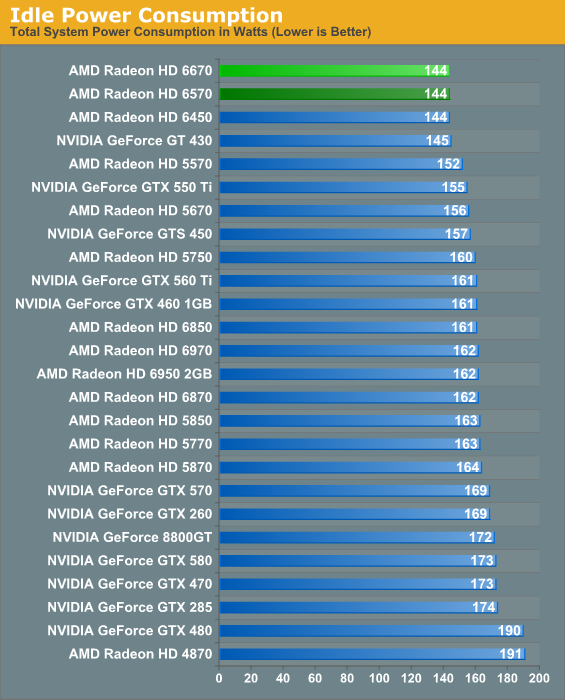
At idle we’re running up against the limits of what a 1200W PSU can do. In reality the 6450 should be consuming at least a few watts less than the 6670 and 6570. The fact that all 3 cards are among the lowest power consuming cards at idle is not a mistake, however.
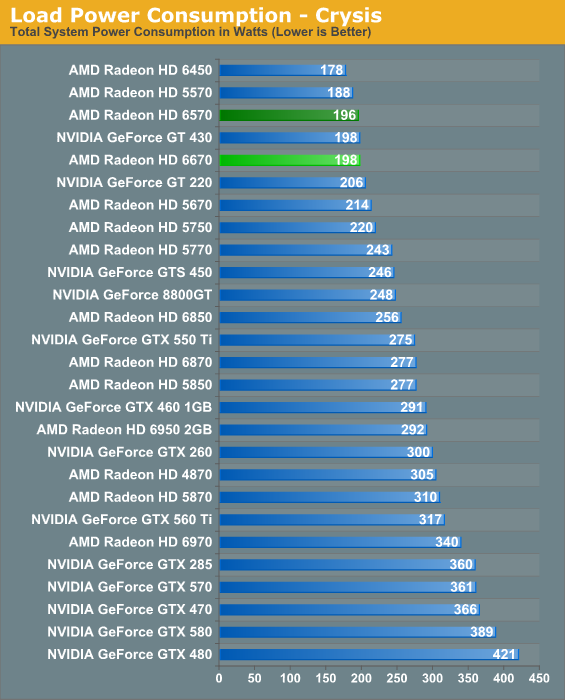
Our Crysis power data surprised us some, and we’re still trying to get to the whys. Both the 6670 and 6570 ended up being sub-200W; this is notable because the 5670 draws 214W in the same test and has a slightly lower TDP than the 6670. In spite of what the specs say, for whatever reason the 6670 is clearly well ahead of the 5670 in both power consumption and performance when it comes to Crysis.
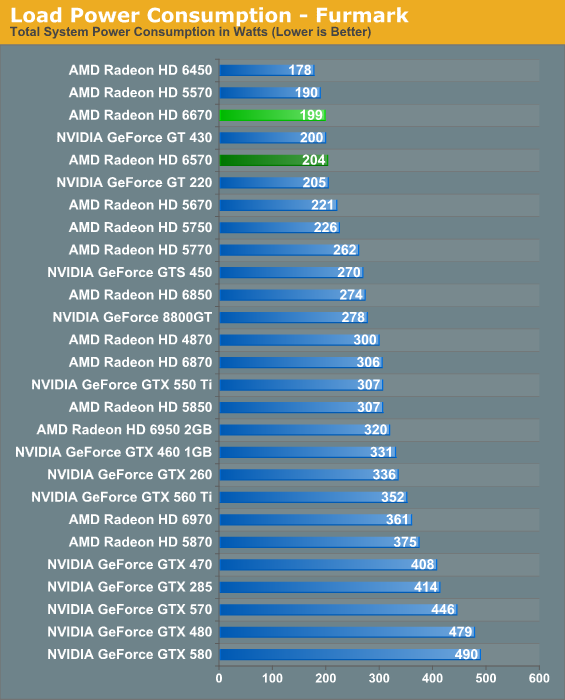
FurMark confirms what we’ve seen with Crysis: the 6670 and 6570 consume less power than the 5670 even with their similar TDPs. In fact the 6570 consumes 5W more than the 6670 even though the latter is the higher clocked and should be the higher consuming card. Given that both cards use fully enabled GPUs at the same load voltage, the difference looks to come down to minor variations in the quality of the individual chips. In this case our 6670 appears to use a better chip than our 6570, hence the difference.
In any case the load power consumption looks very good. The 6670 edges out even the much slower GT 430, while the 6570 similarly edges out the GT 220 DDR3. AMD has done a lot of work on power consumption for Northern Islands and it shows. Meanwhile the fact that the 5750 draws around 25W more is both a curse and a blessing – 25W is quite a lot when Turks cards only draw around 60W in the first place, on the other hand that 25W comes with a lot more performance.
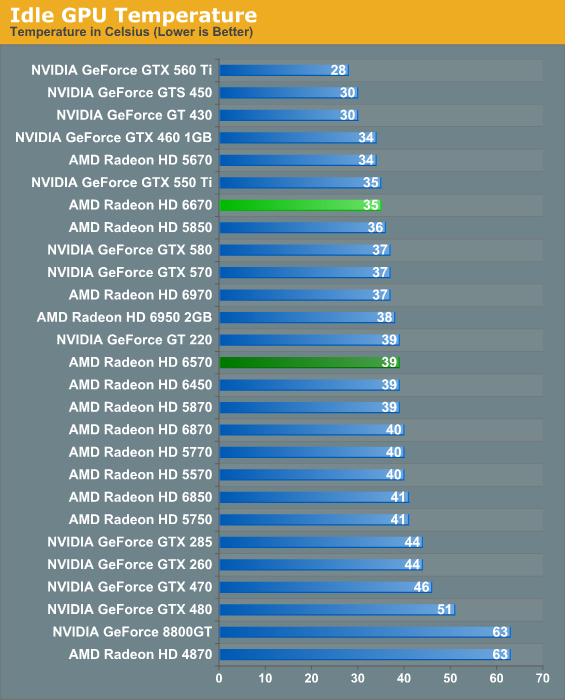
Idle temperatures are roughly where we expect them to be. The 6570 is consistent with the other cards using that model cooler, while the 6670’s new double-wide cooler makes it competitive with all but the coolest of our cards.
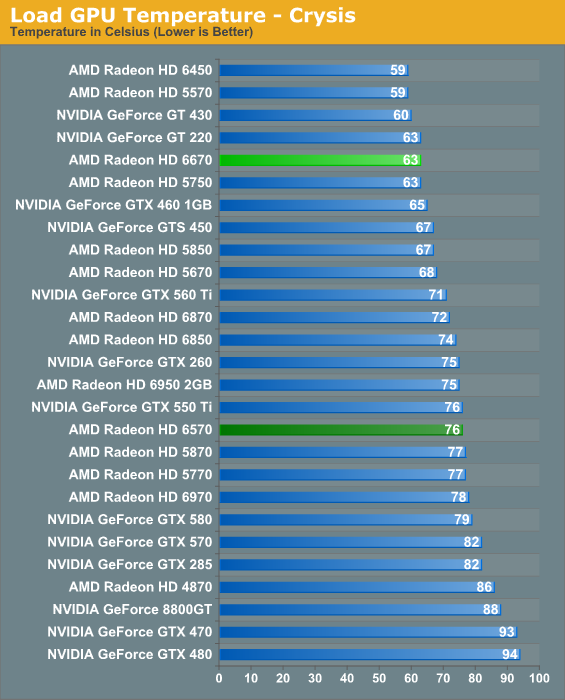
Since we’ve already established that the 6670 and 6570 have similar levels of power consumption, temperatures are almost entirely a product of the cooler in use. The 6670 has a larger cooler that can move more air, and as a result it’s much cooler than the 6570 under Crysis. In fact the 6570 is probably at its limits for what AMD’s single-wide low-profile cooler can do; dissipating the roughly 40W the GPU produces is no small task for such a small cooler.

Coming from Crysis our temperatures rise slightly, as is normally the case. At 69C the 6670 is extremely well cooled, while the 6570 is quite warm at 82C. Though we won’t see either cooler at retail, this should be a good idea of the range we should expect to see. A double-wide cooler should make for a very cool card, while a single-wide cooler delivers reasonable performance but it will definitely be warm.
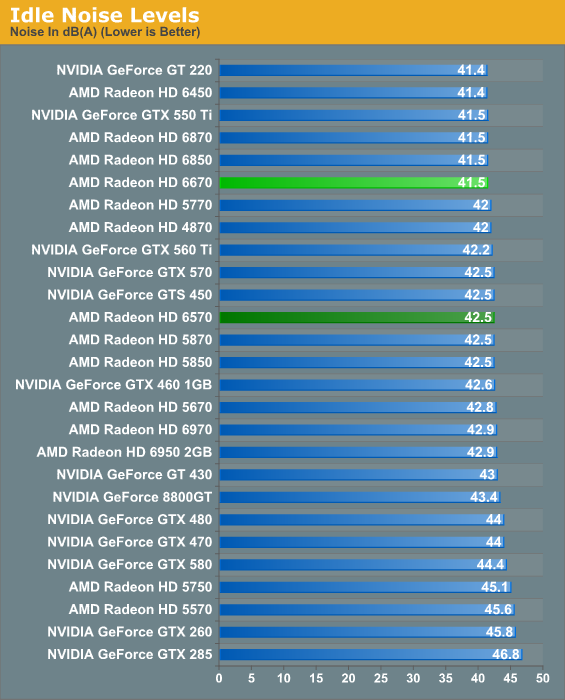
For idle noise, both the 6670 and 6570 are where we’d expect them to be, which is to say almost silent. The 6570 does end up being a bit louder than our noise floor though, which is an interesting outcome given that the 6450 and 5570 are at the noise floor using the same cooler.
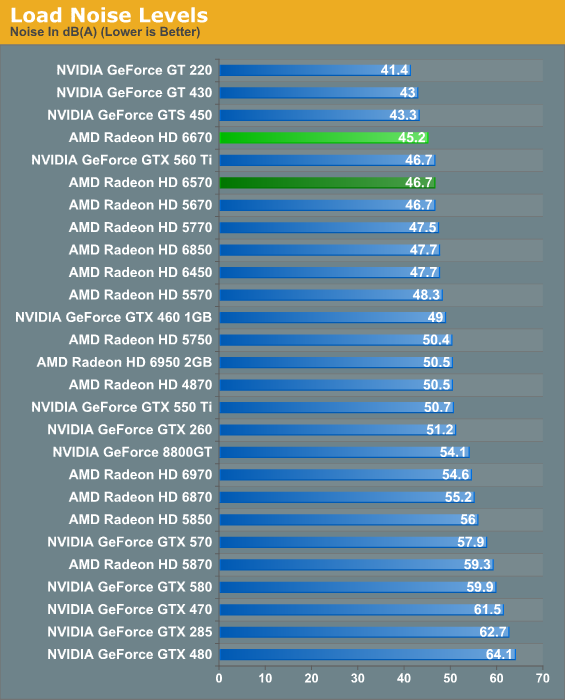
We’re not going to read into our noise results since partner cards will be so different, but if they’re anything like the AMD reference cards then things look pretty good. We’ve had quieter cards, but nothing pushing 60W in a low-profile form factor. If partners go with a full-factor design, then they should be able to meet (or beat) the GTS 450 in noise levels at the cost of some space.
Meanwhile we expect to see passively cooled cards, which should be quite attainable with a full-factor card to hold a larger heatsink.










53 Comments
View All Comments
ClagMaster - Tuesday, April 19, 2011 - link
The HD6670 is a nice upgrade for a 9600GT, both of which are 65W cards.I beleive, based on 240GT performance, that the HD6670 has about 40-50% more performace over the 9600GT.
This card has plenty of performance for games published 4 years ago.
arthur449 - Tuesday, April 19, 2011 - link
Last page, middle of fourth paragraph:"... the Radeon HD 5770 and GeForce GTS 450 are both regularly on sale for under $100 and are easily 30% faster than the 6770."
Shadowmaster625 - Tuesday, April 19, 2011 - link
Newegg has a sapphire 5750 for $103 ARhttp://www.newegg.com/Product/Product.aspx?Item=N8...
Best part is it can apparently be flashed into a 5770.
A 5770 curbstomps a 6670, by more than 50%.
Jasker - Tuesday, April 19, 2011 - link
Finally an actual comparison using an older card. I've been using my 8800 GTS 512 for years and yet to really see a game I could determine for sure was GPU bound (I have an old dual Operaton CPU). Thanks to this article I know I can almost definately see some games with todays mid range cards. Thanks!mosox - Tuesday, April 19, 2011 - link
you don't include the HD video quality benchmark but a load of TWIMTBP games instead.Read Tomshardware for a decent review.
Spivonious - Tuesday, April 19, 2011 - link
Agreed. These cards are not marketed towards gamers. They will more likely be used for media playback and casual gaming, not running Crysis.SlyNine1 - Wednesday, April 20, 2011 - link
No, I wouldn't buy a 6670 for someone thats just going to use it for media playback. There are much better options for that.casteve - Tuesday, April 19, 2011 - link
"The 5570 was the ultimate HTPC card, but the 6450 has dethroned it. "Except Ganesh is still in hiding.....so, you can't say it definatively.
I was going to say, these aren't gaming cards. Then I wandered over to the March 2011 Steam Hardware survey and found ~29% of users had 1280x1024 or less monitors. Yow.
The other humorous factoid was how the 6670 was the equivalent of the venerable 8800 GT; using 30W less in idle and half the power under load. Sort of a nice data point for progress.
But, the biggest missing piece to this article is the analysis for HTPC. How well do the 65xx/66xx score versus the 55xx/56xx/etc? How well do they implement 24fps?
Finally, Adobe is using gpu acceleration for some Photoshop/Lightroom/etc features. It would be nice (instead of Adobe's vague 'you can use your gpu card to accelerate' premise) to have some benchmarks for these lower tier cards to see what they actually do and whether a bottom end card is all you truly need for these apps.
Belard - Tuesday, April 19, 2011 - link
Agreed.Thing is, these new cards are quite usable for people on a budget - for gaming, or to do some gaming in an HTPC, which the 6450 cannot do. I still play games on my rather old 4670.
The video quality and feature set is what makes the 6000 series better than the 5000 and of course the GeForce cards which have severe HTPC / video output issues.
Spivonious - Tuesday, April 19, 2011 - link
Can the charts with noise levels please include the noise floor of the room, or of the system without the video card installed (which I'm assuming is around 41dBA in this case)? Also, can the distance of measurement be included? I would love to see measurements taken at two distances - one next to the case and one about 3-5 feet away to get the level at a normal seating distance.